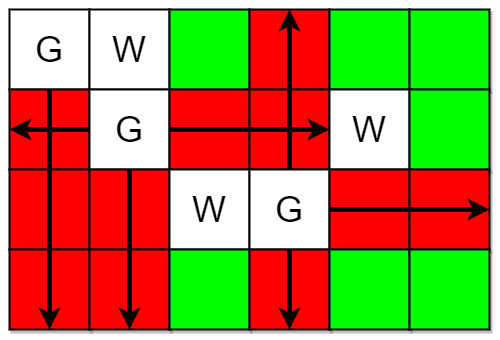Unguarded Cells: grid, hash and a linear approach
The problem this weekend asks for the number of cells that are not guarded. Since the limits of the grid are in the 10^5 range, we're then looking for a O(N) solution.


First, it would be wise to add the positions of the guards and the walls in handy hash-tables. Relatively simple.
After that, think this way: if you scan the grid in a left-to-right analyzing each row, you can increment the cells that are not reached by a guard in that row from left to right. Any cell that has a 1 at the end of this operation is free from guards in that row from left to right.
Now apply the same approach in the other 3 directions: right to left, top down and bottoms-up. By doing so, at the very end, any cell that reaches the number 4 is free from any guard. And that's your answer.
Thus, this would be a 4*m*n, and since m*n<=10^5 (as per the constraint), then the solution becomes O(4*10^5), which is very tractable and considered linear in this case. Code is down below, cheers, ACC.
2257. Count Unguarded Cells in the Grid
Medium
You are given two integers m and n representing a 0-indexed m x n grid. You are also given two 2D integer arrays guards and walls where guards[i] = [rowi, coli] and walls[j] = [rowj, colj] represent the positions of the ith guard and jth wall respectively.
A guard can see every cell in the four cardinal directions (north, east, south, or west) starting from their position unless obstructed by a wall or another guard. A cell is guarded if there is at least one guard that can see it.
Return the number of unoccupied cells that are not guarded.
Example 1:

Input: m = 4, n = 6, guards = [[0,0],[1,1],[2,3]], walls = [[0,1],[2,2],[1,4]] Output: 7 Explanation: The guarded and unguarded cells are shown in red and green respectively in the above diagram. There are a total of 7 unguarded cells, so we return 7.
Example 2:

Input: m = 3, n = 3, guards = [[1,1]], walls = [[0,1],[1,0],[2,1],[1,2]] Output: 4 Explanation: The unguarded cells are shown in green in the above diagram. There are a total of 4 unguarded cells, so we return 4.
Constraints:
1 <= m, n <= 1052 <= m * n <= 1051 <= guards.length, walls.length <= 5 * 1042 <= guards.length + walls.length <= m * nguards[i].length == walls[j].length == 20 <= rowi, rowj < m0 <= coli, colj < n- All the positions in
guardsandwallsare unique.
public int CountUnguarded(int m, int n, int[][] guards, int[][] walls)
{
int[][] count = new int[m][];
for (int i = 0; i < count.Length; i++) count[i] = new int[n];
Hashtable guardsHash = new Hashtable();
for (int i = 0; i < guards.Length; i++)
{
long key = guards[i][0] * (100000 + 5) + guards[i][1];
guardsHash.Add(key, true);
}
Hashtable wallsHash = new Hashtable();
for (int i = 0; i < walls.Length; i++)
{
long key = walls[i][0] * (100000 + 5) + walls[i][1];
wallsHash.Add(key, true);
}
//L->R
for (int r = 0; r < m; r++)
{
bool lastIsGuard = false;
for (int c = 0; c < n; c++)
{
long key = r * (100000 + 5) + c;
if (guardsHash.ContainsKey(key))
{
lastIsGuard = true;
}
else if (wallsHash.ContainsKey(key))
{
lastIsGuard = false;
}
else if (!lastIsGuard)
{
count[r][c]++;
}
}
}
//R->L
for (int r = 0; r < m; r++)
{
bool lastIsGuard = false;
for (int c = n - 1; c >= 0; c--)
{
long key = r * (100000 + 5) + c;
if (guardsHash.ContainsKey(key))
{
lastIsGuard = true;
}
else if (wallsHash.ContainsKey(key))
{
lastIsGuard = false;
}
else if (!lastIsGuard)
{
count[r][c]++;
}
}
}
//T->B
for (int c = 0; c < n; c++)
{
bool lastIsGuard = false;
for (int r = 0; r < m; r++)
{
long key = r * (100000 + 5) + c;
if (guardsHash.ContainsKey(key))
{
lastIsGuard = true;
}
else if (wallsHash.ContainsKey(key))
{
lastIsGuard = false;
}
else if (!lastIsGuard)
{
count[r][c]++;
}
}
}
//B->T
int retVal = 0;
for (int c = 0; c < n; c++)
{
bool lastIsGuard = false;
for (int r = m - 1; r >= 0; r--)
{
long key = r * (100000 + 5) + c;
if (guardsHash.ContainsKey(key))
{
lastIsGuard = true;
}
else if (wallsHash.ContainsKey(key))
{
lastIsGuard = false;
}
else if (!lastIsGuard)
{
count[r][c]++;
if (count[r][c] == 4) retVal++;
}
}
}
return retVal;
}



Comments
Post a Comment